Reconstruction of the capital's downtown? Or of the ministries?
Port-au-Prince, 24 September 2012 – Even though a restrictive government decree that essentially blocked the reconstruction process downtown for almost two years was annulled on May 29, questions, frustrations and doubts abound about the eventual recovery of Haiti’s economic, cultural and political capital. All signs indicate that rather than focusing on the infrastructure work necessary for all sectors, the government is more interested in the reconstruction of its public administration buildings.
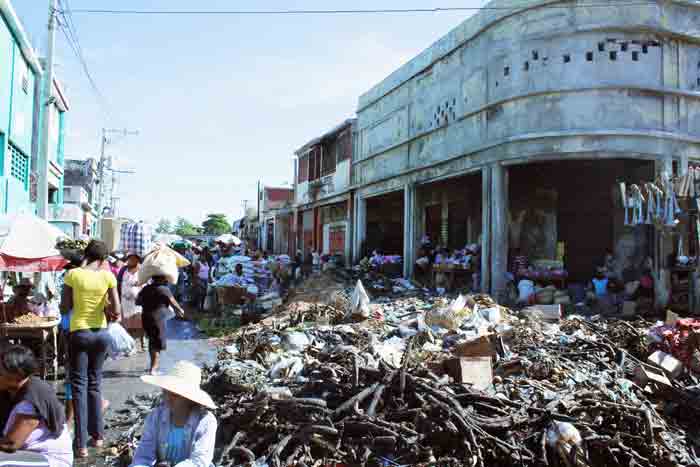
An intersection of Jean-Jacques Dessailines Blvd. (also known as "Grand Rue"
or "Main Street") and a side street, clogged with garbage and street vendors.
Photo: HGW/Evens Louis
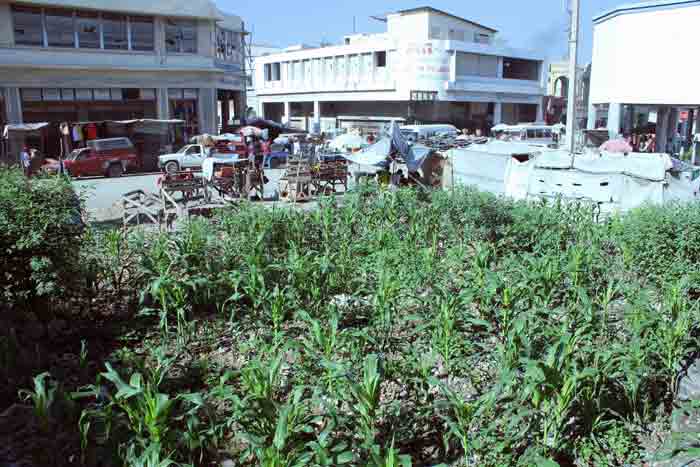
A bean and corn garden at the corner of Rue Pavée and Rue du Centre.
Photo: HGW/Evens Louis
The past 32 months have seen meetings, colloquiums, studies and declarations. Hundreds of thousands of dollars and gourdes have been spent. But a drive through downtown (not always easy, due to garbage and street vendors) shows that, aside from rubble removal, little reconstruction has taken place. Only one significant building has gone up, and one street is under repair. Everywhere else is a jumble of ruins, rubble, at least four corn fields, and mounds of garbage that poison the air.
Business district not in the reconstruction business
Many of the large businesses have left downtown for Tabarre, Petion-ville and Delmas, clearing the way for informal sector vendors who have taken over the dusty streets and sidewalks. Other shopkeepers and businesspeople seem almost hopeless.
“Port-au-Prince will never be like it was 25 years ago,” a shopkeeper in his fifties told Haiti Grassroots Watch (HGW) as he sat in his mostly empty kitchen appliance store on the Rue des Miracles. “Nothing is going to happen,” he said, adding that the shop had been looted in the weeks following the earthquake.
In spite of the determination and confidence shown by the government of President Michel Martelly and Prime Minister Laurent Lamothe, HGW’s investigation and survey of 15 merchants revealed that most remain skeptical and know nothing about plans for downtown. Some are considering moving their businesses due to the degrading conditions in which they are trying to make a living. All of them agreed to speak to HGW only on condition that their identities not be revealed.
“Nothing serious is going on downtown, and I don’t see any proof the government has the will to do a reconstruction. Even though they lifted the restrictions, the situation is the same,” said the owner of a large hardware store that’s been downtown for six decades.
“I heard on the radio that they are going to do zoning, where one zone will be for all the banks, and another for all the public administration buildings, but so far, I have never heard anyone say anything more than that. The way things stand now, I’m not doing anything, because this is a very messed up country. You can go ahead and do something that you think is the right thing and in the end, it’s you who lose out,” she added.
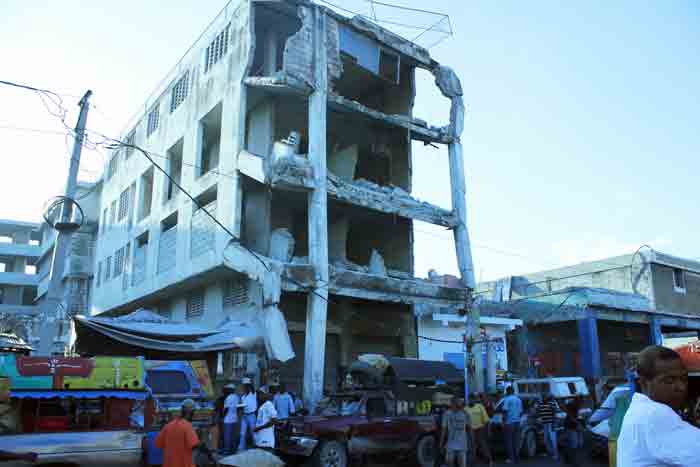
The skeleton of a building looms over the pedestrians, vehicles and vendors on Jean-Jacques Dessalines Blvd. Photo: HGW/Evens Louis
But the government is enthusiastic.
“Downtown was and will again be the economic heart of the country. It will be even better than it was. We have to finish the studies. We have been working very seriously, non-stop,” explained Michel Présumé of the relatively new government’s Unité pour la construction des logements et de bâtiments publiques (UCLBP or Unit for the Reconstruction of Housing and Public Administration Buildings) in a June 19, 2012, interview.
A useless “public usefulness” decree
The January 12, 2010, earthquake was one of the greatest urban disasters of modern times. In addition to the estimated 300,000 killed, “[t]he quake produced urgent reconstruction costs estimated at $11.5 billion, destroyed over 80 per cent of Port-au-Prince and several towns and villages close by and flattened the seats of all three branches of government along with fifteen of the seventeen ministries, 45 per cent of the police stations and a number of courts,” the International Crisis Group wrote in a March 31 2010 report.
Then came the decree of September 2, 2010. The government resolution, from President René Préval, designated about 200 hectares “or public utility” or “usefulness.” All reconstruction was illegal.
“All construction, building of roads, division of lots, or any other exploitation of the land, including any and all real estate transactions, are and remain prohibited for all of the area defined in Article 1,” Article 2 of the decree reads.
Michelle Mourra, a founding member of SOS Centre-ville (SOS Downtown), an organization that claims to defend the rights and interests of all the property owners, merchants and other people who use of downtown, said the decree was “a terrible blow.”
“The private sector probably suffered worst material loses than any other sector on January 12, 2010,”she wrote in an email to HGW on July 16, 2012. “The public utility decree was an even worse setback, because we had to watch, powerless, for two years while downtown was looted and destroyed. We could not legally rebuild and start up our activities again, which are job-producers and which generate revenue for the state.”
Despite the founding of SOS Downtown, despite complaints from the business sector, and despite the change in government in May 2011, the decree wasn’t annulled for another 12 months. On May 29, 2012, the Préval decree was replaced with five new Martelly ones, including one that designates a much smaller area “of public utility.” (The others indicate different zones as “protected,” “reserved” or as “national heritage.”)
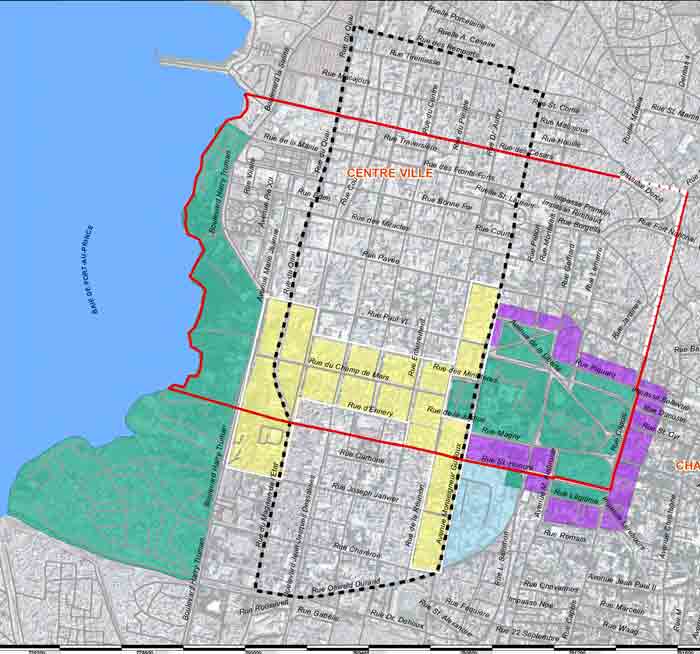
The red lines indicate the Préval "utilité public" decree area, and the yellow
shading indicates the new "utilité public" area. The areas that are green and
purple have other designations. Source: Government of Haiti
With the annulation of the decree, “we have taken an important step forward, and that’s positive,” Jean-Christophe Adrian, former director of UN-HABITAT, told HGW on June 20, 2012. UN-HABITAT is the United Nations agency that specializes in housing and urban development. “The downtown area necessarily plays a very important role for the city of Port-au-Prince, and for Haiti in general, because this downtown, once it is reconstructed, will become the heart of Haiti, one hopes.”
The 2010 decree is not the only hurdle in the quest to reconstruct downtown. But when it comes to plans, there’s no shortage.
Many plans and sketches have been proposed and several studies have been published. The British Prince Charles Foundation and the Miami urban planning company Duany-Plater-Zyberk (DPZ) did a plan that cost the Haitian government at least US $295,000. The Haitian firm Trame/CHRAD, together with former mayor of Port-au-Prince Muscadin Jean-Yves Jason presented another. [See Dossier 7 - Impasse? What's Blocking the Capital's Reconstruction?]
The Ministry of Planning and Overseas Cooperation (MPCE in French), together with UN-HABITAT, held meetings in July 2010, and a forum “Vil nou vle a” (“The city we want”), reportedly attended by 700 people, in November 2011. According the organizers, writing in the 68-page booklet of the proceedings, “the meetings and the forum were a process of participatory planning in order to assure that the major actors take into account the opinions of the populations concerned.”
The same document mentions that the main firm involved in the reconstruction of the downtown is the Canadian firm Daniel Arbour and Associates (also known as IBI/DAA Group). IBI/DAA is developing “six planning sketches and 18 urban plans” for six areas: “Port-au-Prince, the Jacmel-Marigot axis, the Palmes axis [Léogâne, Petit and Grand Goâve], Les Cayes and the surrounding area, the metropolitan area and commune of Cap-Haïtien and the commune of St. Marc.”
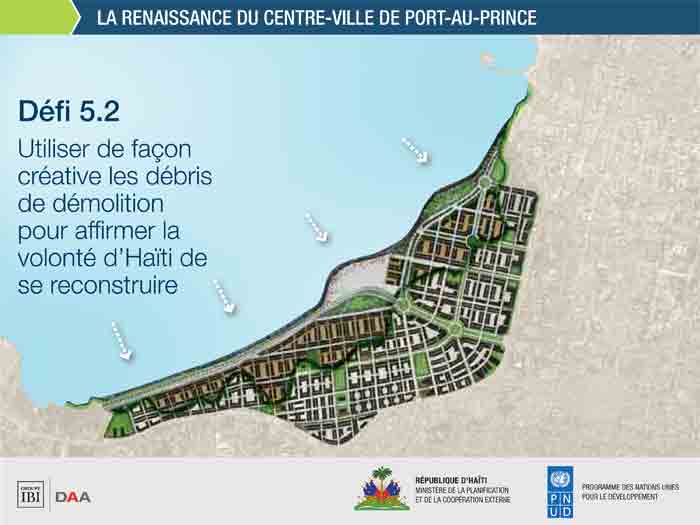
This page from the IBI/DAA presentation dated November 31, 2011, recommends
that rubble and debris be used to fill in parts of the capital's port area to create
green space and to "affirm Haiti's will to reconstruct."
HGW could not find information about all of the 24 sketches and urban plans. However, UCLBP Coordinator Harry Adam said the plan for the “administrative corridor” of Port-au-Prince cost between US $135,000 and US $150,000. Présumé confirmed that the plan had been delivered, but that it was not yet public. He also noted that he didn’t have details about the other plans or work that the firm has completed or will complete for the government.
While HGW could not find details of the total cost of all of the contracts being executed or already executed by IBI/DAA, a document posted on the Ministry of the Economy and of Finances (MEF in French) dated September 15, 2012 – “Etat des décaissements pour les projets financé par les fonds Petrocaribe” (“State of accounts for the projects financed by the Petrocaribe Funds”)* – notes that US$4 million has been allocated for the “Execution of Studies for Public Administration Buildings.”
Infrastructure is Important
In their November 31, 2011, presentation IBI/DAA wrote that one of the major challenges would be to construct and reconstruct neighborhoods that have “security and services, integrated into existing neighborhoods.” The Canadian firm also noted the importance of “infrastructures,” saying it would be necessary to “provide neighborhoods with infrastructures and improve the quality of life” with the “provision of potable water, energy, pedestrian and vehicle access, sanitation and sewer services, [and] access to telecommunications and internet linkages.”
It is completely normal to have several plans for the reconstruction of downtown Port-au-Prince, according to UN-HABITAT’s Adrian, but infrastructure is key.
“It’s good that there’s a debate around certain ideas, but there’s a moment where one must say, ‘Okay, now let’s do a synthesis of all of these, let’s take the best from Prince Charles, the best from Trame, the best from the others, and let’s set up the framework and let’s move forward,” he said.

Street vendor stalls in front of closed stores early one morning on
Jean-Jacques Dessalines Blvd. Photo: HGW/Evens Louis
Présumé agrees.
“Sooner or later, we need to have a master plan for downtown, and also for the metropolitan area, for greater Port-au-Prince,” Présumé said, adding that UCLBP will be the agency doing the synthesis, as well as overseeing the construction of administrative buildings.
The UCLBP, together with the MPCE and many other ministries, the mayor’s office, the Interministerial Committee for Territorial Planning (CIAT in French) and other organisms and agencies will work with financing from the Haitian government, Petrocaribe Funds, debt relief monies and grants, including the recently announced gift of US$4 million from Taiwan.
Already the UCLBP has opened three work sites for three ministries: the Ministry of Foreign Affairs and Religions, the Ministry of Commerce and Industry, and the Ministry of the Interior. The overall price tag for the government, according to the above-mentioned MEF document, is US$35 million. The Petrocaribe document – which lists projects totaling over US$750 million – doesn’t mention any infrastructure work for Port-au-Prince’s downtown.
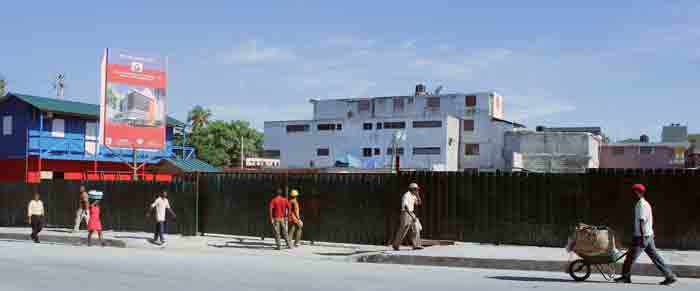
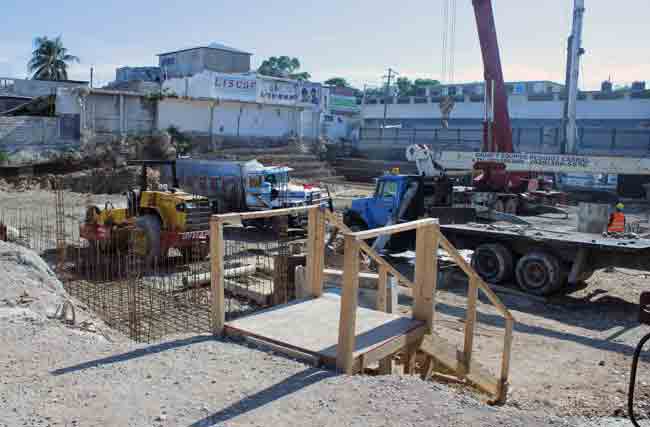
Above: Two photos of the Ministry of the Interior worksite. The sign does
not say who is executing the work, but according to the MEF document,
US$15 million has already been disbursed. HGW believes the work is being
executed by HADOM, owned by Dominican Senator Félix Ramon Bautista,
or perhaps one of his other businesses. All were involved in the controversial
"no-bid" contracts awarded just before the René Préval-Jean Max Bellerive
government stepped down in 2011. See Dossier 19 for details and links
Photos: HGW/Evens Louis

Above: Image from the government document "Priority Projects - Financed
by Petrocaribe and IMF Debt Forgiveness" with a rendering of the Ministry
of the Interior.
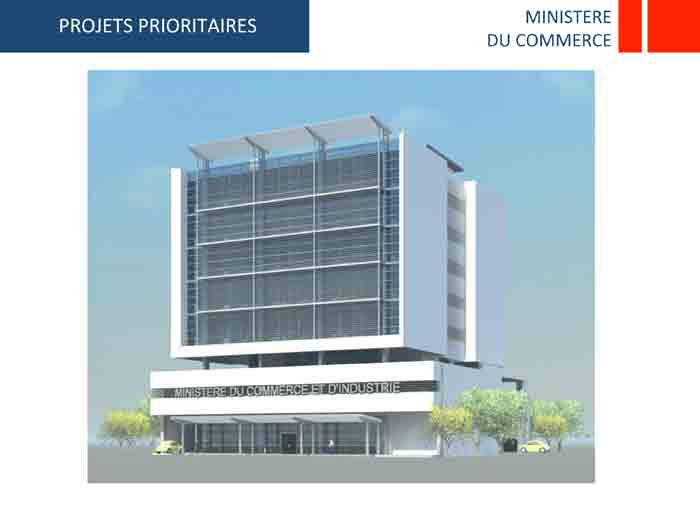
Above: Another image from the same document, showing a rendering
of the planned Ministry of Commerce.
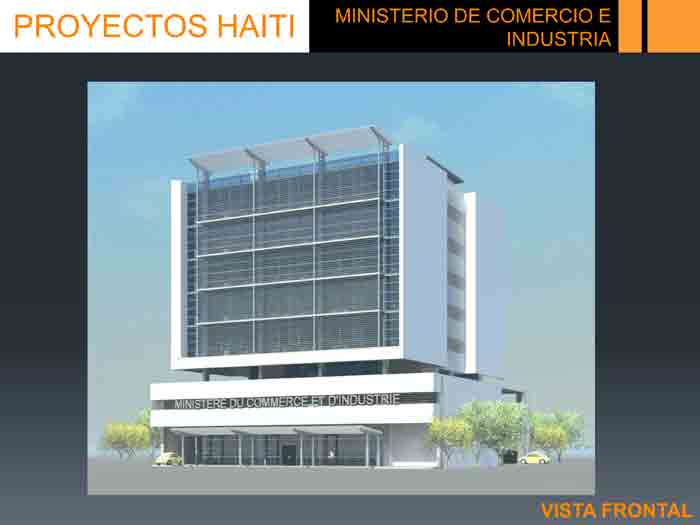
Above: Exact same image, this time in a document called "Proyectos Haiti" put out by HADOM,
a company owned by Dominican Senator Félix Ramon Bautista. The document proposes 11 projects totalling US$ 340 million. HGW does not know if all of these projects were funded,
but as noted above, it is possible HADOM is constructing the three ministries currently under
construction. The price tag for the Ministry of Commerce, according to the MEF document,
is US$10 million.
While the government certainly has other documents and other sources of financing, Présumé was clear that the government could not undertake all of the reconstruction.
“A country can’t develop without a dynamic private sector. The private sector must accompany [the government],” he said, adding, “We need to be much more realistic and let these people really start!”
SOS Centre-ville agrees that the reconstruction is a “konbit” (collective labor effort).
“The reconstruction of downtown, and of the rest of Port-au-Prince, is a massive job. The government can’t do it alone. We are all concerned. The moment has come for everyone to collaborate,” Mourra wrote in her July 16, 2012, correspondence. But, she and other actors note, the private sector cannot take the first step.
“The first thing is to improve the infrastructures,” UN-HABITAT’s Adrian agreed. “You can’t reconstruct if the streets aren’t repaved, if there is no drainage system, if there is no water, if there is no electricity. You need roads, sanitation systems and electricity. That’s what needs to happen first.
According to Présumé, all of that will happen.
“We must create conditions for the private sector where it feels at ease, protected and accompanied, so that it can then take risks,” he said. “The government will play an important catalyst role. The first steps will certainly be taken by the Haitian government.”
How do the business people feel?
In an email interview dated September 13, 2012, Mourra was still semi-optimistic: “The big government works haven’t really started, but there’s been a beginning.”

A view of the Ministry of Foreign Affairs work site on Harry Truman Blvd.
Photo: HGW/Evens Louis
Interviews conducted by HGW last July discovered many doubts, incertitude and frustrations. Most of those who agreed to talk said they did not know the content of the new decrees and that they knew even less about the various meetings.
“I never went to any meeting. I was never formally invited,” the hardware store owner said. “The people around here, we are never invited. They invite the ‘insiders.’ They invite the bank directors, the department stores owners, people like that.”
Like all the merchants who agreed to be interviewed, she was “very skeptical.” The door of her store – which had to be moved into a former depot after the earthquake – is difficult to see behind piles of trash and street vendor stands. Big trucks can’t get near the store, she said, adding that she believes this has caused some clients to defect to other vendors.
The insecurity is even more worrying.
“The first thing we need is police. The officers are lazy and don’t seem to care, or they are afraid. And they have reason to be afraid! Because they aren’t trained to do the work they ought to be doing, which is to protect and help the population. That’s the first thing we need, but we don’t even have that,” she said.

A typical corner on Jean-Jacques Dessalines Blvd. Note the crumbling old building
with a newer concrete second floor. A young girl holding a baby stands on a roof nearby.
Photo: HGW/Evens Louis
"Will" vs. Action
Finally, the National Palace is being demolished – although by the US humanitarian group JP/HRO run by actor Sean Penn. And there are the three ministries, recently visited by President Martelly.
And after that? There is “a will,” according to many of the actors.
“There is political will at more than one level. The president of the republic is really engaged. That is the first thing,” Adrian said.
Présumé said much the same.
“The authorities really do have the will to do things,” he said.
But the reflections of the shopkeepers don’t sound the same.
“If they did have will, they would have begun already. There are still places that haven’t even been cleared of rubble! All the money stays at the top, it doesn’t come down. In other words, the poor don’t have a government,” said a woman who has a wholesale soft drink business, as she got her hair done at a small beauty salon.
“Everyone likes beautiful things,” added a another woman works at a small air conditioner supply shop. “Even in Puerto Rico, or the Dominican Republic, everything looks at least a little nice. You would really like your country to look like all the other ones. But here, it’s ‘look out for yourself only’ here. Everyone is just looking out for his or her wallet. Once [politicians] make their money, they’re satisfied. I’ll only believe in [reconstruction] when I see it. I would love it to happen, because I like beautiful things, clean things.”
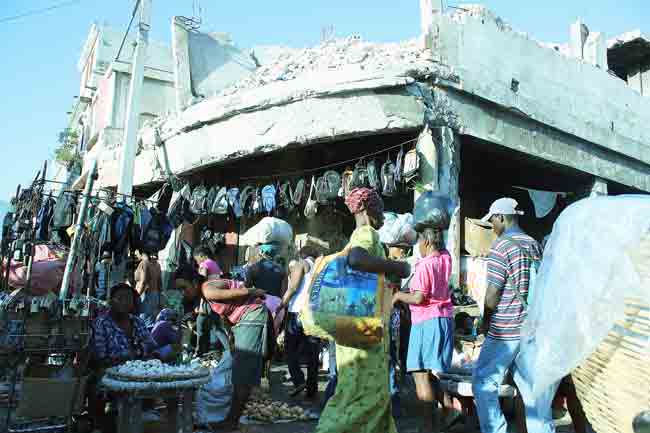
Food and a baseball hat vendors set up in front of a crumbling hulk of a building.
Photo: HGW/Evens Louis
“I’m not going to say anything. I’m not expecting anything. Until the return of Christ, I have no choice but to work to take care of my family, but nothing in this country interests me, because it will never be the way it was before,” complained the kitchen appliance shopkeeper in his nearly empty store.
Présumé, who is in charge of overseeing the construction of public administration buildings for the UCLBP, has an answer for journalists and for those who doubt downtown will be reconstructed.
“It’s true, we have a culture where talk is cheap but action never happens. You are right to doubt. But me, I will tell you that we are very serious and we are going to deliver.”
Présumé’s supervisor, UCLBP coordinator Harry Adam, agrees that the reconstruction of downtown was blocked for a long time.
In an interview on August 8, 2012, Adam noted that what’s needed is “a private sector that has plans, dynamic projects with the resources necessary to accomplish them, and a government that sets the tone.
But the hardware store owner needs more than “tone.”
“I am not interested in investing one gourde [about 2 US cents] until they start taking care of the infrastructure,” she said.
If the UCLBP is only in charge of public buildings, who is responsible for reconstructing downtown? Which entity will do the infrastructure work? City Hall? The Ministry of Planning? The Ministry of Public Works? And who in charge of coordinating all the work?
* This fund is the result of an accord that allows the Haitian government to get petroleum products from Venezuela and then sell them to local companies. A percentage of the revenue becomes a 25-year loan with an interest rate of one percent. The government often uses the money to finance development projects.
Go to Housing Exposition Exposes Waste, Cynicism
Return to introduction

